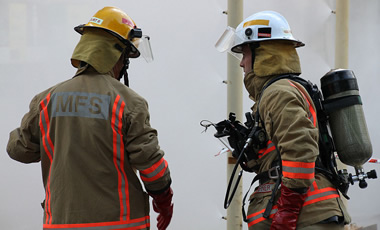
Researchers have developed a new tool and updated guidance to help first responders and emergency managers determine how best to decontaminate a massive number of people after chemical exposure.
The updated guidance on chemical decontamination, called Primary Response Incident Scene Management or PRISM, incorporates new scientific evidence in what it refers to as the “triple protocol” – which involves disrobing and conducting dry decontamination, wet decontamination using the ladder pipe system with high volume/low pressure water deluges from fire trucks, and technical (or specialist) decontamination. The researchers say these three steps remove 99.9 percent of chemical contamination.
“When we began working with the University of Hertfordshire six years ago, our goal was to provide emergency managers and first responders with scientific evidence and guidance they needed to make fundamental and fast decisions on how to save the greatest number of lives in chemical emergencies,” said Biomedical Advanced Research and Development Authority (BARDA) Director Rick Bright. “Building on the first ground-breaking studies and guidance, we now have a larger body of scientific evidence that is incorporated into the latest guidance, and we have made it even easier for responders to use in preparing for disasters and on the scene in an emergency.”
BARDA developed the updated guidance along with the University of Hertfordshire in the United Kingdom.
The triple protocol approach is faster and more effective than traditional methods for treating chemically contaminated patients, the researchers contend. Further, immediate “dry” decontamination using any available absorbent material can be highly effective as a stand-alone procedure, removing up to 99 percent of contamination.
“Disrobing and dry decontamination are steps that can be taken by the affected individuals themselves under the direction of response personnel, without waiting for equipment set up,” Bright noted. “The addition of dry decontamination to the overall response also minimizes the accumulation of hazardous material in the subsequent decontamination steps.”
The guidance recommends that first responders have enough absorbent materials available on emergency response vehicles so that emergency dry decontamination can begin as quickly as possible. Further, they should make sure that there are enough washcloths and towels for use in wet decontamination, and blankets or temporary clothes to protect patients from hypothermia afterward.
Also, experts from BARDA, the National Library of Medicine (NLM) at the National Institutes of Health, and the University of Hertfordshire created a decision-support tool called ASPIRE or the Algorithm Suggesting Proportionate Incident Response Engagement. The tool is designed to help responders determine which decontamination approaches will work best in a given situation. With the ASPIRE tool, emergency management planners and responders can tailor decontamination plans and emergency responses based on the chemical and the type of exposure, how quickly the chemical evaporates, and the amount of time that has passed since exposure.
Both ASPIRE and the updated guidance are integrated into the Chemical Hazards Emergency Medical Management (CHEMM) online resource manual created by NLM and the Office of the Assistant Secretary for Preparedness and Response within the U.S. Department of Health and Human Services. They will also be incorporated into the latest edition of the CHEMM mobile app.




